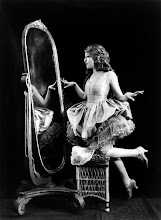 One phrase I absolutely hate is when people mention the "good old days of film" and how old films were so "clean" and "nice". These people have obviously never watched old films or just have a hard time picking up the subtle nuances of sex, vulgarity, crime, and other hidden messages in old films. In fact, the early days of Hollywood can be defined into two periods of time: the Pre-Code days when anything goes and the days of the Production or Hays Code, where everything still went, as long as you could sneak around the rules or put in some hidden subtexts.
One phrase I absolutely hate is when people mention the "good old days of film" and how old films were so "clean" and "nice". These people have obviously never watched old films or just have a hard time picking up the subtle nuances of sex, vulgarity, crime, and other hidden messages in old films. In fact, the early days of Hollywood can be defined into two periods of time: the Pre-Code days when anything goes and the days of the Production or Hays Code, where everything still went, as long as you could sneak around the rules or put in some hidden subtexts. The name "Hays Code" comes from Will H. Hays, a man who's resume includes chairmen of the Republic National Committee, Post Master General, and most famously, the enforcer of the United States Motion Picture Code of 1930, which bears his name. It was Hay's job to clean up the movies, which many social and religious groups across the country thought were too filled with sex, violence, and other messages they didn't want their children to be exposed. To learn more about Hays, you can read this article.

There are about three incidents one can cite that led to the implementation of the Code. One of the incidents was when comedian Fatty Arbuckle's career was decimated after the mysterious death of Virgina Rappe, which you can read about here. When famed director William Desmond Taylor was murdered, believed to be by Mabel Normand, as well as the death of Wallace Reid, seemed to cement the Hays Code as needed in Hollywood to stop all of the immorality that was ventured off the screen and into real life.
The popular gangster movies of the era were a major subject of disgust among the Code supporters. Post-code, movies were not allowed to create sympathy for "the side of crime, wrongdoing, evil, or sin". "Brutal killings" and themes of "revenge" were also prohibited. Scenes of "sexual vulgarity", were also prohibited, including white slavery, seduction and rape, excessive and lustful kissing, and scenes of passion. In addition, ridicule of religion, respect for the Flag, suggestive dancing, and bedroom scenes that were not "tasteful" were not permitted. If you want to read the full rules and regulations of the code, you can read them here. Of course, all of these rules went against the envelops that Hollywood was trying to push, not to mention the groups who were Pro-Code were not the majority
of Americans.

The Code went on to ruin, damage, or change the lives and careers of memorable Hollywood icons. Including those who's careers were ruined before the code, several others found themselves lacking in work after the code was implement. Mae West suffered under what was known as "Hays Fever" because of her raunchy routines and comedy, which you can read about here. Living performers weren't the limit either. Cartoons such as Betty Boop and even Porky Pig cartoons by Disney were censored for not fitting in with code requirements. You can read more about Betty Boop and the Code here. At the bottom of this post, you can watch the most controversial Betty Boop cartoon.

The Hays Code fell by the wayside in 1968 when it was replaced by the MPAA standards. There never really were "innocent days" in Hollywood, just like there never were innocent days in real life. Hollywood learned how to get around the code and that period is known as the "Golden Age of Film", not because of the morality rules imposed by the Hays Code but because Hollywood continued to push new ideas and content even with the rules placed on them.






No comments:
Post a Comment